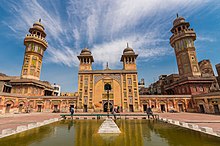| Wazir Khan Mosque | |
|---|---|
وزیر خاں مسیت مسجد وزیر خان | |
 | |
| Religion | |
| Affiliation | Islam |
| Location | |
| Location | Lahore, Punjab, Pakistan |
| Geographic coordinates | 31°34′59″N 74°19′24″E / 31.58306°N 74.32333°E |
| Architecture | |
| Architect(s) | Wazir Khan |
| Type | mosque and Sufi mausoleum |
| Style | Indo-Islamic, Mughal |
| Groundbreaking | 1634 |
| Completed | 3 December 1641 |
| Specifications | |
| Dome(s) | 5 |
| Dome height (outer) | 21 feet (6.4 m) |
| Dome height (inner) | 32 feet (9.8 m) |
| Dome dia. (outer) | 19 feet (5.8 m) |
| Dome dia. (inner) | 23 feet (7.0 m) |
| Minaret(s) | 4 |
| Minaret height | 107 feet (33 m) |
The Wazir Khan Mosque (Punjabi: وزیر خاں مسیت, romanized: Wazīr Khã Masīt; Persian, Urdu: مسجد وزیر خان, romanized: Masjid Wazīr Khān) is a 17th-century Mughal masjid located in the city of Lahore, Punjab, Pakistan. The mosque was commissioned during the reign of the Mughal Emperor Shah Jahan as a part of an ensemble of buildings that also included the nearby Shahi Hammam baths. Construction of Wazir Khan Mosque began in 1634 C.E., and was completed in 1641.[1] It is on the UNESCO World Heritage Tentative List.[2]
Considered to be the most ornately decorated Mughal-era mosque,[3] Wazir Khan Mosque is renowned for its intricate faience tile work known as kashi-kari, as well as its interior surfaces that are almost entirely embellished with elaborate Mughal-era frescoes. The mosque has been under extensive restoration since 2009 under the direction of the Aga Khan Trust for Culture and the Government of Punjab,[4] with contributions from the governments of Germany, Norway, and the United States.[5]
- ^ "Conservation of the Wazir Khan Mosque Lahore: Preliminary Report on Condition and Risk Assessment" (PDF). Aga Khan Development Network. 2012. Retrieved 25 August 2016.
The Wazir Khan Mosque was built in 1634-35 AD (1044-45 AH), by Hakim 'Ali ud din* a governor of Punjab in the early part of the reign of the Mughal emperor Shah Jahan.
- ^ "Badshahi Mosque, Lahore". UNESCO World Heritage Centre. UNESCO. Retrieved 7 May 2020.
- ^ Masson, Vadim Mikhaĭlovich (2003). History of Civilizations of Central Asia: Development in contrast : from the sixteenth to the mid-nineteenth century. UNESCO. ISBN 9789231038761.
- ^ "Walled city of Lahore conservation". Retrieved 25 August 2016.
The Walled city of Lahore is famous for several historic monuments including the Lahore Fort – a World Heritage site, the Badshahi and Wazir Khan mosques. Close to 2,000 buildings within the Walled city display a range of architectural features that mark Lahore's centuries-old cultural landscape. A majority of these buildings and the mohallas (local neighbourhoods) in which they are situated form a unique heritage footprint. The work consequently carried out by the Aga Khan Trust for Culture (AKTC) and the Aga Khan Historic Cities Programme (AKHCP) was initiated under a 2007 public-private partnership framework agreement with the Government of Punjab.
- ^ Muzaffar, Zareen (8 February 2016). "The Walled City of Lahore: Protecting Heritage and History". The Diplomat. Retrieved 25 August 2016.
The Walled City of Lahore program was put into effect in partnership with the Aga Khan Trust for Culture. AKTC supports the Walled City Authority in all technical matters in terms of restoration and conservation work being carried out. Other donors include the World Bank, Royal Norwegian Government, USAID, and the German Embassy.
